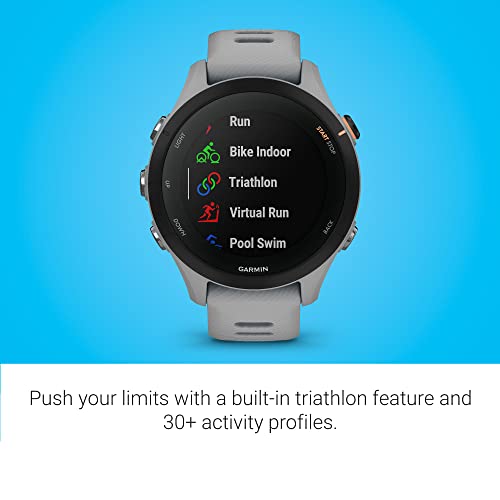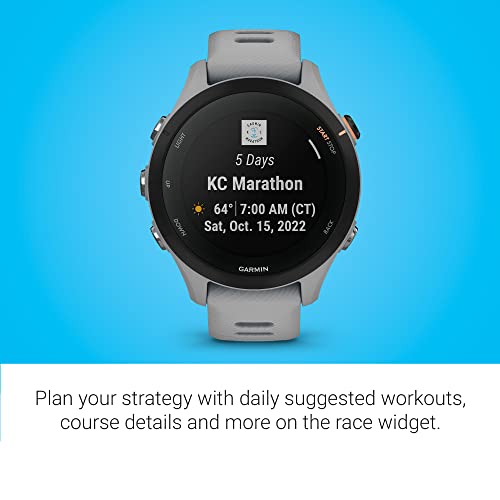⚡ Key Specifications
✅ Best For
- Runners with smaller wrists
- Female athletes seeking pro features
- Those who find 46mm watches too bulky
- Ultralight racing preference
- Youth/junior athletes
⚠️ Not Recommended For
- Those wanting AMOLED displays
- Users needing navigation maps
- Large data field preference
- Those with wrists over 180mm
📷 Product Images (17 total)

















✓ Pros
- Incredibly lightweight at 39g - barely noticeable on wrist
- Same pro features as 255 - no compromises for size
- Dual-band GPS accuracy in compact form
- 12-day battery life still exceptional
- Perfect for smaller wrists (under 170mm)
- Music storage available (Music version)
- Full triathlon and multisport support
- Morning Report with HRV status
- Excellent value at $349
✗ Cons
- MIP display looks dated vs AMOLED
- No touchscreen navigation
- Smaller display can feel cramped
- No navigation maps
- 2 days less battery than regular 255
📱 Display
Transflective MIP • 1.1" • x
Always-On🔋 Battery Life
12 days typical use
26 hours GPS
❤️ Health Tracking
Heart Rate SpO2 Sleep Stress🛒 Where to Buy - All Retailers
Garmin Forerunner 255S
Overview
The Garmin Forerunner 255S proves that smaller doesn’t mean less capable. This 41mm powerhouse packs every single feature of the acclaimed Forerunner 255 into a compact, 39-gram package that’s perfect for smaller wrists. With dual-band GPS, music storage options, full triathlon support, and 12-day battery life, it’s the small wrist champion that refuses to compromise on performance. At $349, it’s arguably the best compact running watch for serious athletes.
The Small Wrist Champion
Finally, a watch that doesn’t punish smaller wrists:
- 39g weight: Lightest full-featured Garmin
- 41mm case: Proportional on 140-170mm wrists
- 18mm bands: Huge variety of options
- Same features: Zero compromises vs regular 255
- Better comfort: Less bounce during running
This is the watch female runners have been waiting for—professional features without the bulk.
Size Comparison Reality
vs Regular Forerunner 255 (46mm)
- 5mm smaller diameter: Noticeable difference
- 10g lighter: 20% weight reduction
- Narrower bands: 18mm vs 22mm
- Smaller display: 1.1 inch vs 1.3 inch
- Identical features: Everything else the same
The size difference is significant—if you’ve found 46mm watches overwhelming, the 255S transforms the experience.
Dual-Band GPS Excellence
Same professional accuracy as the larger model:
- L1 + L5 frequencies: Top-tier precision
- All GNSS systems: GPS, GLONASS, Galileo
- SatIQ technology: Smart battery management
- Urban canyon handling: Tall buildings no problem
- Dense forest tracking: Maintains accuracy
- Clean Strava uploads: No embarrassing zigzags
The compact size doesn’t compromise GPS performance—accuracy remains exceptional.
Battery Life That Delivers
Slightly less than regular 255, but still impressive:
- Smartwatch mode: 12 days typical
- GPS tracking: 26 hours continuous
- Multi-band GPS: 13 hours precision mode
- GPS + Music: 6.5 hours streaming
- UltraTrac mode: 48 hours ultra distance
12 days between charges means no battery anxiety—exceptional for this size.
Music Without the Phone
255S Music model adds ($399):
- 4GB storage: 500 songs offline
- Spotify integration: Download playlists
- Amazon Music: Sync subscriptions
- Deezer support: Additional option
- WiFi syncing: Fast transfers
- Bluetooth headphones: Universal compatibility
Perfect for runners who hate carrying phones but need their motivational playlist.
Training Features Excellence
Morning Report 2.0
Wake up to personalized insights:
- HRV status overnight
- Sleep quality score
- Recovery level
- Training readiness
- Weather overview
- Suggested workout
Start every day with context about your body’s readiness.
Daily Suggested Workouts
Adaptive coaching on your wrist:
- Analyzes training history
- Considers recovery status
- Balances workout types
- Adjusts for missed sessions
- Includes recovery runs
- Progresses appropriately
Like having a coach who knows your schedule and fitness.
Race Widget and Predictor
Goal race preparation:
- Current fitness predictions
- 5K, 10K, half, marathon times
- Training tips for distance
- Countdown to race day
- Weather tracking
- Performance condition
Keeps you focused and motivated toward race goals.
Triathlon and Multisport
Full triathlon support in compact form:
- Multisport mode: One-button transitions
- Open water swim: GPS tracking in water
- Pool swim: Automatic lap counting
- Brick workouts: Combined training
- Race activity: Complete event tracking
- Transition timing: T1 and T2 recorded
Everything triathletes need, nothing they don’t.
Real-World Performance
For Female Runners
Designed with women in mind:
- Proportional on smaller wrists
- Doesn’t slide during runs
- Lighter for less fatigue
- Women’s health tracking
- Pregnancy mode available
- Menstrual cycle insights
Finally, pro features without masculine sizing.
Marathon Training
Complete package for 26.2:
- 26-hour GPS covers any pace
- Training status tracking
- Long run recovery metrics
- Race predictor motivation
- Suggested workouts adapt
- Music for tough miles
From first miles to race day, fully supported.
Trail Running
Surprisingly capable off-road:
- Barometric altimeter for elevation
- Storm alerts for safety
- Breadcrumb navigation
- Sunrise/sunset times
- Trail running activity
- 26-hour battery for ultras
Only missing maps for complete trail dominance.
Health and Recovery
HRV Status
Heart rate variability insights:
- 7-day baseline establishment
- Overnight measurements
- Trend visualization
- Recovery insights
- Stress impact shown
- Training guidance
Understand your body’s readiness scientifically.
Body Battery Energy
0-100 energy monitoring:
- Real-time energy levels
- Activity drain visible
- Rest recharge tracked
- Sleep impact clear
- Stress effects shown
- Optimal training timing
Know when to push and when to rest.
Advanced Sleep Tracking
Comprehensive sleep analysis:
- Sleep stages detailed
- Sleep score provided
- Respiration rate
- Movement tracking
- Consistency insights
- Recovery quality
Better sleep leads to better performance.
Display Considerations
MIP Display Reality
Traditional screen has trade-offs:
Advantages:
- Always visible without backlight
- 12-day battery life
- Perfect in bright sun
- No burn-in ever
- Proven durability
Disadvantages:
- Only 64 colors
- Not vibrant indoors
- Needs backlight at night
- Looks dated in photos
- Lower resolution
Function over form—perfect for pure performance focus.
Screen Size Impact
1.1 inch display considerations:
- 4 data fields: Comfortable maximum
- 5-6 fields: Readable but cramped
- Maps: Would be too small (not included)
- Notifications: Shorter preview text
- Navigation: Button-based works great
The smaller screen is totally usable—just shows less at once.
Compared to Competition
vs Forerunner 265S ($449)
- 265S adds: AMOLED display, Training Readiness
- 255S advantages: $100 cheaper, better battery
- Verdict: 255S unless display is priority
vs COROS PACE 3 ($229)
- PACE 3 wins: Price, 24g weight, 30-day battery
- 255S wins: Features, ecosystem, music option
- Verdict: 255S for features, PACE 3 for minimalism
vs Forerunner 165 ($249)
- 255S wins: Dual-band GPS, battery, barometer, features
- 165 wins: AMOLED display, touchscreen, $100 cheaper
- Verdict: 255S for serious runners, 165 for casual
vs Polar Pacer Pro ($299)
- 255S wins: Music option, triathlon, ecosystem
- Pacer Pro wins: Running power included, lighter
- Verdict: 255S more complete package
vs Apple Watch SE ($249)
- 255S wins: Battery, GPS accuracy, running features
- Apple wins: Display, apps, smart features
- Verdict: 255S for runners, Apple for lifestyle
Who Should Buy the 255S?
Perfect For:
- Runners with wrists 140-170mm
- Female athletes wanting pro features
- Those finding 46mm watches too large
- Ultralight racing enthusiasts
- Triathletes needing compact multisport
- Serious runners prioritizing comfort
Skip If:
- You want AMOLED display beauty
- Need navigation maps
- Prefer large data displays
- Have wrists over 180mm
- Smart features are priority
- Budget under $300
Living with the 255S
Daily Experience
The lightweight design transforms daily wear:
- Forget you’re wearing it
- Sleep tracking comfortable
- No desk-bumping bulk
- Professional appearance
- Quick-dry after shower
- All-day comfort
Training Integration
Seamlessly supports serious training:
- Morning Report starts day
- Suggested workout guides
- Auto-sync to Strava
- Recovery metrics inform
- Training status tracks
- Race widget motivates
Garmin Ecosystem
Full ecosystem access:
- Garmin Connect app
- Connect IQ apps/faces
- Compatible sensors
- Training plans
- Social challenges
- Coaching features
Tips for New Owners
- Give HRV time: Needs 19 days for accurate baseline
- Customize data screens: Optimize for your eyes
- Try suggested workouts: Surprisingly effective
- Enable incident detection: Safety first
- Download music overnight: WiFi can be slow
- Use Race Widget: Great for motivation
- Join challenges: Community keeps you going
Music Version Decision
Get Music Version If:
- You run alone frequently
- Hate carrying your phone
- Long runs need entertainment
- Gym workouts without phone
- Trail runs want less gear
Skip Music If:
- Always run with phone
- Prefer podcasts (limited support)
- $50 matters more
- Never use Spotify/Amazon Music
Long-Term Value
Investment Perspective
At $349 for 4+ years use:
- $87 per year
- $7.25 per month
- $0.24 per day
- Less than weekly energy gel
Durability
Garmin build quality:
- 4-5 year typical lifespan
- Regular firmware updates
- Features added over time
- Excellent customer service
- Strong resale value
Common Questions Answered
“Is the screen too small?” For 4 data fields, it’s perfect. For 6+, you’ll squint. Most runners use 3-4 fields anyway.
“Can men wear the 255S?” Absolutely! If you have smaller wrists or prefer lighter watches, gender doesn’t matter.
“Is 12 days enough battery?” Unless you’re doing 100-mile races weekly, 12 days is plenty. Most users charge weekly by habit.
“Should I wait for 265S?” The 265S exists now with AMOLED for $100 more. If you want MIP battery life and value, get 255S.
Hidden Features Worth Knowing
- Track Mode: Improves GPS accuracy on track
- ClimbPro: Shows upcoming climbs on courses
- Safety features: LiveTrack and incident detection
- Gear tracking: Monitor shoe mileage
- Connect IQ: Thousands of apps/faces
- Strength training: Counts reps automatically
- Garmin Pay: Contactless payments
Verdict
The Garmin Forerunner 255S is a triumph of engineering—proving that smaller watches don’t need to compromise on features. At 39 grams with a 41mm case, it’s perfectly proportioned for wrists under 170mm while delivering every professional feature of its larger sibling. The dual-band GPS, music storage option, triathlon support, and comprehensive training metrics make it a complete platform for serious athletes.
Yes, the MIP display looks dated compared to newer AMOLED models, but the 12-day battery life and always-on visibility are worthwhile trade-offs. The smaller screen requires some adjustment, but it’s perfectly usable for training data. At $349, you’re getting features that cost $500+ in other brands, all in a package that you’ll barely notice on your wrist.
For runners with smaller wrists who’ve been forced to choose between professional features and comfortable fit, the wait is over. The 255S delivers both without compromise. It’s the best compact running watch available—powerful enough for professionals, comfortable enough for 24/7 wear, and priced fairly for the value delivered.
Bottom line: If you have smaller wrists and serious running goals, the Forerunner 255S is your watch. It’s proof that the best things really do come in small packages.